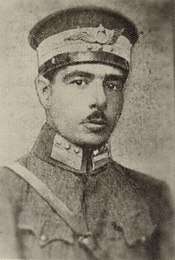Vecihi Hürkuş
Vecihi Hürkuş (6 January 1896 – 16 July 1969) was a Turkish aviation engineer and aviation pioneer, who fought during World War I and the Turkish War of Independence. He designed and manufactured the first airplane in Turkey, and also founded the country's first airline company.
Vecihi Hürkuş | |
|---|---|
 | |
| Born | 6 January 1896 |
| Died | 16 July 1969 |
| Occupation | Aviator, engineer and entrepreneur |
Biography

Born in Istanbul in 1896. His father was customs inspector Feham Bey, his mother was Zeliha Niyir, born in Vidin. His father died when he was 3 years old. He went to elementary school in Bebek, Füyuzati Osmaniye Rüştiye (middle school) in Uskudar and Paşakapısı İdadi (high school). Then he finished Tophane Art School.
When Balkan War started, he joined as volunteer. Upon his return, he was assigned as the commander of a POW camp in Beykoz. Then during World War I, in early 1916, he was sent to, Bagdat, during Mesopotamia Campaign as a mechanic[1]. He was sent back to Istanbul after he was injured. He subsequently joined Tayyare Mektebi, the Ottoman aviation school in Yeşilköy. His first solo flight was on 21 May 1916. Soon after receiving his pilot certificate he joined 7th airplane company (Tayyare Bölüğü) and commenced bombing and reconnaissance missions against the Russians on the Caucasus front. In one of these sorties, he shot down a Russian airplane, becoming the first Turkish pilot to bring down an enemy aircraft.
He was subsequently taken prisoner by the Russians but managed to escape from Nargin island to Iran by swimming with Azeri help and walking for over two months. Following his escape, he returned to Istanbul and joined the 9th combat aircraft squadron in 1918, assigned to protection of Istanbul from aerial attacks by Allies. He designed a fighter airplane but could not finish the project due to the terms contained within the Montreux Ceasefire Agreement. During the Turkish War of Independence, in which he flew as a "civilian pilot", he held the equivalent rank of Captain. During this time he shot down a Greek airplane,[2] and made the first and last flights of the war. In the last flight, he landed at İzmir Seydiköy Airfield, occupying it single-handedly.
After the war, he designed and built his first airplane and a few other aircraft inside a converted saw mill which he had rented. He used aircraft engines he had acquired during World War I to power these planes. In 1924 he built a military aircraft from scratch in Izmir, Vecihi K-VI, which made its first flight on 28 January 1925. In 1930 he constructed a speedboat (Vecihi-SK-X) and a civilian aircraft (Vecihi K-XIV) in Kadıköy, Istanbul, followed by a seaplane in 1933.
On 21 April 1932, he established a civilian flying school, Vecihi Sivil Tayyare Mektebi, in Kadıköy. The following year he trained the first Turkish female aviator, Bedriye Bacı (Gökmen). He adopted the surname Hürkuş ("Freebird") after the Surname Law of 1934. On 27 February 1939 he received a diploma in aircraft engineering from the Weimar Engineering School in Germany.
In 1948 he established a privately-funded aviation publication entitled Kanatlılar Dergisi. On 29 November 1954 he founded Hürkuş Havayollari (Freebird Airlines), the first private airline in Turkey. From 1961 to 1966 he conducted aerial surveys for the Mining Research Institute.
Aviation contributions

In 1917, Hürkuş became the first Turkish aviator to fly a twin-engine aircraft, a Russian Caudron G.4 captured at the Caucasian Front. In 1918 he manufactured a propeller from scratch in Istanbul, for a Nieuport 17 also captured from the Russians. During the Turkish War of Independence he produced adhesive from gelatin to glue fabric to aircraft wings.
In 1923, in Edirne, Hürkuş flew an abandoned Italian Caproni Ca.5 aka Ca.57 or Breda M-1 with nine passengers, the first Turkish pilot to fly a passenger aircraft. He constructed the country's first gliders (US–4 ve PS–2), and played a role in the establishment of the Turkish Bird[3] (Turkish Aviation Society) from 1935 to 1936 in Etimesgut, Ankara.
During his flying career, which spanned 52 years (1916–1967), Vecihi Hürkuş flew a total of 102 different models of aircraft and spent 30,000 hours (3.4 years) in the cockpit.
Personal life
During the War of Independence, Vecihi married Hadiye, the daughter of the chief of police in Akşehir. They had two daughters, Gönül (Hürkuş Şarman) and Sevim (Hürkus Maxson). In 1925, he divorced Hadiye and married his childhood sweetheart İhsan. Another daughter, Perran (Ülgen-Hürkuş), was born in 1927.
Legacy
In 1994, Hürkuş was honoured posthumously with the International Civil Aviation Organization's (ICAO) 50th Anniversary Award for his contributions to civil aviation in Turkey.
The TAI Hürkuş turboprop trainer to be built by Turkish Aerospace Industries is named after Vecihi Hürkuş.[4][5]
See also
Sources
- Vecihi Hürkuş, Havalarda, 1915-1925, İstanbul, Kanaat Kitabevi, 1942.
- Vecihi Hürkuş, Bir Tayyarecinin Anıları: Yaşantı, İstanbul, YKY, 2000 ISBN 978-975-08-0219-5
- Mehmet Gürbüz Gürer, Vecihi Hürkuş "Göklerin Korkusuz Adamı", İstanbul, 2001.
- M. Bahattin Adigüzel, Türk Havaciliğinda İz Birakanlar, Ankara, 2001.
- Tayyareci Vecihi Hürkuş Müzesi Derneği https://tayyarecivecihi.com/
References
- https://www.fikriyat.com/biyografi/2018/07/16/havacilikta-ilklerin-adami-vecihi-hurkus
- http://www.kokpit.aero/index.php?route=article/article&article_id=4387
- https://www.thk.org.tr/
- TAI Turkish Aerospace Industries, Inc.
- Turkish Aerospace Industries (June 2007). "Aviation Week - Show News - Turkey's New Trainer Gets Old Name: Hurkis". Archived from the original on 22 July 2011. Retrieved 22 August 2010.
External links
- Biography
- War of Independence-Military Action in 1920 (in Turkish)
- Hürkuş
- Turkish Aerospace Industries-TAI
- Photos about Vecihi Hürkuş
| Wikimedia Commons has media related to Vecihi Hürkuş. |